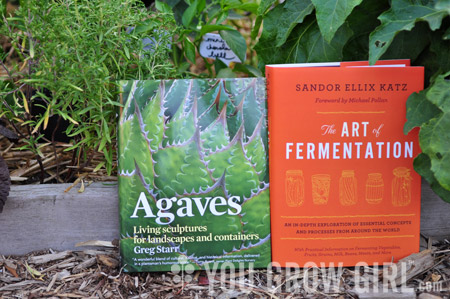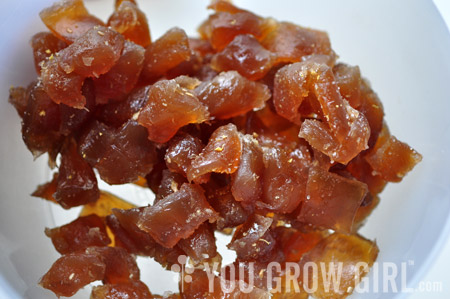
How is it that my last book roundup was published all the way back in April? Just today I was remarking to Davin that this gardening season feels like it is going by in a blink of an eye, and this proves it. One minute I am waiting impatiently for the winter to recede, and the next it is mid-July and I am eating the year’s first ripe tomatoes off of the plants.
They say (whoever they is) that time moves faster as you get older and/or also when you are having fun. My birthday is in two weeks. One more year before I am officially confirmed as OLD. Fortunately, I am having fun.
Agaves: Living Sculptures for Landscapes and Containers by Greg Starr
This first book showed up at my door as a review copy from the publisher. I may be repeating myself here, but I rarely include review copies in my book roundups (they are typically personal purchases) because the publishers tend to get it wrong and send me the strangest titles from their catalogues. Not this time. I gasped aloud when I opened up the envelope and this book popped out. I was headed out to an appointment at the time and brought it along in my bag because I simply could not wait until later to dive into it. If you’re an agave lover (as I am) or just have an interest in learning more about them, I think you’ll love this book. It would be especially useful to those of you in warmer climates who can actually grow some of these beauties outside year-round. I should note here that the topic of sort-of hardy agaves is covered in the first chapter called “Growing Agaves.” This section also includes a list of the hardiest species, of which there are two that can withstand my zone given the right conditions: Agave toumeyana and Agave utahensis. Note to self that I must try to get one to test in my Dry Bed! An agave outside year-round, in the ground would make my life. I noted on my trip to the Denver Botanic Gardens last year that they had several Agave parryi growing year-round in their alpine garden and it has had me thinking since about the possibilities here at home.
The book is full of useful information as well as photos of gorgeous plants that had me drooling and itching to expand my potted collection even though I can barely handle the nearly 20 plants I have as-is. Many shots in the book depict agaves in their element set against gorgeous mountain-scapes and dry scrubland. It has brought the wanderlust back full force. Another field trip to the desert where I can see fully mature agaves in their majesty is imperative! And because the book is first and foremost about using agaves in the garden, there is plenty about that, too.
The Art of Fermentation: An In-Depth Exploration of Essential Concepts and Processes from Around the World by Sandor Ellix Katz
In case you are wondering, the fermentation addiction is still going strong. I continue to juggle several cultures at once — a feat that is at times tedious and tiresome and other times exciting and challenging in the best possible way. And yet I struggle everyday with the eagerness to start another. Alas, there is so much to ferment and not enough time!
To make matters worse, Sandor Ellix Katz, author of “Wild Fermentation: The Flavor, Nutrition, and Craft of Live-Culture Foods” has come out with an impressive, nearly 500 page tome that dives down much more deeply into the world of fermented foods and beverages. This book is a real achievement. There must be hundreds of accounts of fermented products from around the world within the books pages. I haven’t had a lot of time for reading lately and have found myself stealing glances whenever I’ve had a few spare moments. It has served to increase what was already a fervent enthusiasm for the subject. I really can’t say enough good things about this book.

And Then I Made Kombucha Candy
One of the things that I really appreciate about the book is that Sandor seems more interested in furthering and encouraging experimentation than telling the reader how to do things in a specific way. As a result, there are no recipes per-se so much as there are loose instructions on how to go about trying for yourself. When I came upon the idea for “Kombucha Candy: Nata” on pages 174-175, I knew I had to give it a shot. I had two HUGE mothers/SCOBYs (Find out how to grow one over here) and I really wanted to experiment with them rather than tossing them into the compost bin as I have been.
According to Sandor, the process he has used involves cutting a sheet of kombucha into bite-sized pieces and then rinsing and boiling them repeatedly to remove excess acidity. Once that is accomplished, he simply cooked the pieces in a lot of sugar — “roughly as much sugar as kombucha cubes” — and then lay it out to dry. He also mentions a friend’s method that omits the rinsing and boiling to preserve the acidity. I decided to come in somewhere in the middle. I rinsed twice, once before and once after boiling. I cooked mine in a bunch of sugar, but I grated in some ginger using a Microplane [as an aside: I don’t often promote products here but this is one of my most beloved kitchen tools] and then used it again near the end to throw on some lemon zest for good measure. This idea came to me as I was cooking the kombucha bits. It made sense to flavour them in this way as our favourite way to flavour the drink is with ginger and lemon. The thick and sticky pieces also reminded me of chewy ginger candies, so it came as no surprise when Davin remarked that the finished product tasted like a cross between those candies and apple pie! Actually, the apple pie remark was a surprise, especially since it is exactly as Sandor’s friend describes the candy in the book.
I did not dry my candies as long as Sandor seems to suggest, but I did place them in the oven for a short period of time. Once cooled, I transferred them to the fridge. I felt that they could probably stay out for a while, but it is currently fruit fly season.
These candies really are a revelation and proof positive that even an unappetizing blob of bacteria and yeast can be made into something not just palatable, but delicious.
Yeah!! I designed and set The Art of Fermentation. I’m so glad you are enjoying it. You know he will be in California for the Heirloom Festival in Santa Rosa in September. You would love it too. Just sayin…
Wow, I love that!
Oh, I would most keen to attend the Heirloom Festival in Santa Rosa… I am always California dreaming.
I live in Santa Rosa. So excited to hear that! I’m definitely going to have to go! Also excited to try making nata. What a cool idea.
I can attest to the fact that this antimicrobial candy tastes goOd – I had not just 1 but 2 pieces (didn’t want to overdo it – just in case)! Thanks Gayla.
PS – I just downloaded the kindle version of The Art of Ferm … thAt should be fun reading it on my iPhone (someday I’ll get the ‘real deal’ – holding a book is a much more pleasing tactile experience but right now my wallet has reached ‘squeaky clean’)
PPS – I just read that the kombucha culture can also be used to make artificial leather … thank goodness because right now I think I have enough to make a cute little purse!
Again – thank you Gayla!
Fantastic recipe and one that has me heading to The Book Depository to buy myself a copy. Cheers for the heads up and for the wonderful recipe.